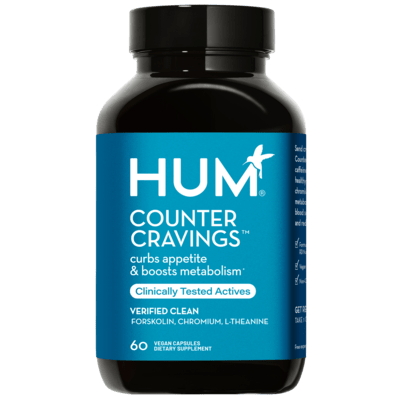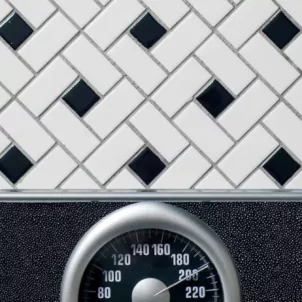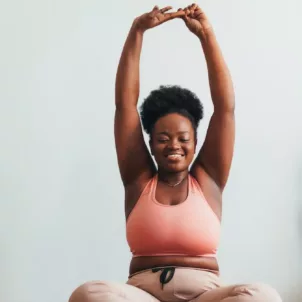Are your blood sugar levels the key to better health? I used a continuous glucose monitor for a week to find out what my favorite meals were doing to my body.
The first thing most people think of when they hear the term blood sugar is diabetes, but blood glucose levels are a key marker of metabolic health for everyone—including people with and without diabetes or prediabetes. Metabolic health has become increasingly buzzy in recent years with a new wave of companies making it easier than ever for anyone to monitor their blood sugar levels as a way to get health insights.
Of course, when I heard about these personal devices, I was intrigued. Could blood sugar monitoring really be the secret to weight loss, peak performance, and sky-high energy levels? I tried a continuous glucose monitor (CGM) for a week to find out—and dove deep into the blood sugar biohacking world.
What is Blood Sugar?
As you may have guessed, blood sugar, or blood glucose, is the amount of glucose found in your blood at any given time. This glucose comes from the foods we eat and is the main energy source for our bodies. “You can think of glucose as a direct measure of our metabolism and metabolic health; it’s the newest vital sign,” says Kara Collier, RDN, LDN, VP of Health at NutriSense, a metabolic health company that combines CGMs with expert nutrition guidance.
According to Collier, “When considering how to prevent the most common chronic diseases, all roads lead back to glucose.” But the value of glucose is more nuanced than that, explains Collier. “Understanding our baseline glucose values gives us insight into our metabolic health, level of insulin resistance, consistency in energy levels, inflammation, longevity, aging, cognitive function, as well as athletic performance.”
To get a closer look into your blood sugar levels, continuous glucose monitors offer a relatively pain-free, easy way to see what’s going on inside your body.
What are Continuous Glucose Monitors?
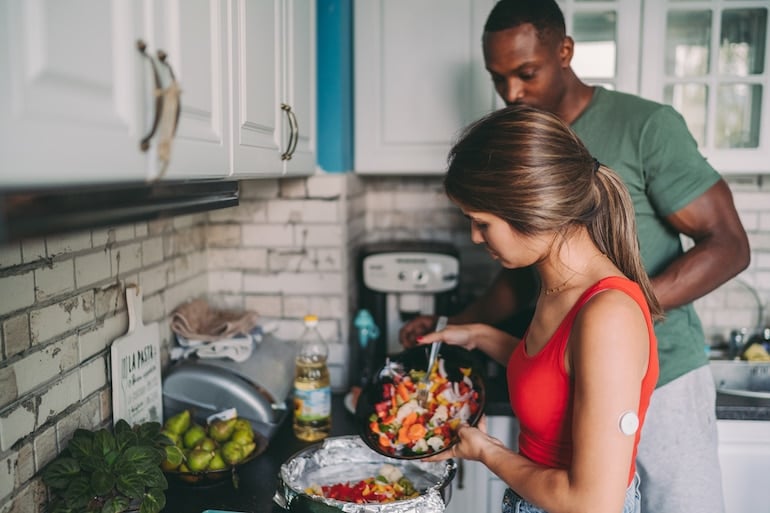
Continuous glucose monitors are devices worn on the body to measure blood sugar levels over time. They were initially created to help people with diabetes monitor their levels, but a February 2022 study in The American Journal of Clinical Nutrition and sponsored by metabolic health company Zoe found CGMs are reliable enough to be used for personal nutrition guidance.
If you’ve ever had your glucose levels measured at the doctor as part of a routine check-up, they likely measured your hemoglobin A1C. This measures your average blood glucose levels over the past 3 months. While it’s a helpful tool in diagnosing diabetes and prediabetes, it doesn’t show you how your blood sugar levels change in response to certain foods, exercise, sleep, and things like medications and supplements. CGMs, on the other hand, are able to provide more granular data because they take a measure of your glucose every few minutes.
What are Healthy Blood Sugar Levels?
“When specifically studying people without diabetes, of normal weight, and normal health status, we generally want to see blood sugars stay between 70 and 140 mg/dl 95 percent or more of the time,” Collier explains. When fasting, levels should be between 70 and 90 mg/dL, she explains. “Values greater than 90 are associated with increased risk of cardiovascular disease, diabetes, insulin resistance, and atrophy of the hippocampus and amygdala.”
These are a few other blood sugar goals most people should aim for:
1. You can recover from a meal within 2-3 hours of eating.
If you’re wearing a CGM, ideally your peak glucose will be less than 140 mg/dl after a meal and return to pre-meal levels within 2-3 hours of eating. “We want to avoid dramatic spikes and prolonged increases,” explains Collier.
“When someone has recurrent bumps above 140 (and especially if those exceed 160), we begin to see reduced insulin sensitivity, an increased risk for diabetes, impaired beta cell function, higher free fatty acid concentrations despite higher prevailing insulinemia, higher risk of cancer, cardiovascular disease, and an overall increase in inflammation.” Importantly, this doesn’t mean you can never eat a meal that spikes your blood sugar above 140 mg/dl, just that those meals should not be an everyday occurrence. As with most things, it’s all about balance.
2. Your glucose doesn’t swing dramatically.
If you look at your glucose levels on a graph (which you can do through CGMs that transmit data to an app), ideally your glucose does not spike high and drop dramatically in a short time period. “Optimally, we aim to keep that change in our glucose to less than 30 points at a meal,” explains Collier. For instance, if you start at 80 mg/dL, you would want to keep the spike to under 120 mg/dL.
3. You feel energized during your day-to-day.
While CGMs provide data and insights, it’s important to also ask yourself how you feel after eating certain things. If you feel your energy levels crashing midday or after eating a certain food, you can look to your glucose levels to help determine where you’re at and how you can avoid a dip in the future.
During times like this, you may even notice something called reactive hypoglycemia, says Collier. “This is when your ending glucose is lower than where it was before you started eating,” she explains. “This often happens when people consume a larger portion size of sugary foods or refined carbohydrates, such as flour-based foods. The large influx of easy-to-digest sugar causes the pancreas to overcompensate by pumping out too much insulin, which plummets the blood sugar lower than when it started.”
My 7-Day Food and Activity Log Wearing a CGM
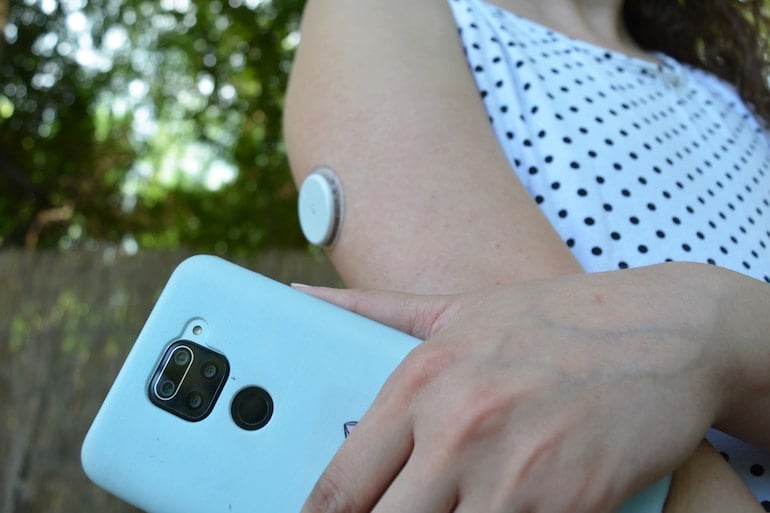
I decided to try NutriSense because not only do they provide you with a CGM and have an easy-to-use app to view all of your blood sugar data, but they also pair you with a dietitian to answer any questions you have along the way. At HUM, we also provide our subscribers with dietitian support, so I know firsthand how helpful it is to be able to tap an expert.
Unlike other health and fitness wearables like an Apple Watch or heart rate monitor, CGMs are somewhat invasive. They contain a small needle that pierces through the skin—and stays there usually for up to 14 days, worn on the back of your arm. Honestly, this was the biggest hurdle for me given my phobias of needles and blood. But alas, I do love science. After putting off this story for literally months, I finally sucked it up. (Or rather, I made my husband do the actual application of the medical device so I didn’t really have to look.) And it was… totally fine. I barely felt a pinch when he applied the sensor.
Quite literally armed with my CGM, I spent the next week tracking how my body responded to different foods (from my healthful weekday salads to the flaky almond croissant of my French girl dreams) and activities. Here’s what happened:
Day 1
I waited until after a big swim workout that morning to apply my sensor as it’s not recommended at depths below 3 feet and for longer than 30 minutes. (As a synchronized swimmer, I’m usually in deep water for an hour each practice.)
I knew my blood sugar levels were likely low after my workout because I don’t like to eat much before. That and I was starving! I love treating myself to an egg-y brunch after swimming. I popped over to one of my favorite spots and ordered a cold brew coffee with oat milk and cheddar scrambled eggs on a biscuit. Even with the refined carbs in the biscuit, the protein in the eggs kept my blood sugar from spiking as high as I thought it might after this meal. Though two hours after eating, my levels were lower than when I started (not a good sign!).
For dinner, I had a salad with kale, pickled onions, walnuts, blue cheese, and grilled chicken with lemon juice and olive oil dressing. I added some Simple Mills Almond Flour Crackers. This meal netted me nearly perfect numbers with no large spikes.
Day 2
I’ve been trying intermittent fasting for about the past 6 weeks. Five days a week, I do a 16:8 fast, so my eating window is usually 12:30 p.m. to 8:30 p.m. I do still drink cold brew coffee with a splash of oat milk in the morning, which some argue breaks a fast. Luckily, my blood sugar remained steady even after my coffee, so for me, it seems I’m able to stay in a fasted state.
For lunch, I grabbed Sweetgreen’s Super Green Goddess salad, which contains black lentils, chickpeas, roasted sweet potatoes, raw carrots, spicy broccoli, shredded cabbage, raw beets, roasted almonds, baby spinach, shredded kale, and green goddess ranch. My body responded well to this, with a 22-point difference between pre-meal and peak levels and two hours later I had nearly recovered.
By 7 p.m. my blood sugar was the lowest it had been all day—and I could feel it! But I still needed to squeeze a workout in before dinner. I had half of a banana and 1 tbsp peanut butter to hold me over and give me some energy. My pre-meal to peak delta was 32, which surprised me for such a low-cal snack, but as I learned from Collier, there is not a direct correlation between calories and blood sugar.
After a 45-minute dance cardio and sculpting workout, I made dinner—salmon with green beans topped with feta cheese, walnuts, a lemon olive oil dressing, and tater tots. I clocked a 26-point difference between pre-meal and peak levels and after two hours I was fully recovered. This was impressive because I also had a serving of Tate’s Cookies (nom) an hour after dinner and was still able to quickly recover, maybe due to my pre-dinner workout. All in all, a successful day!
Day 3
Another day of intermittent fasting with my first meal of the day at 1:30 p.m. Another Sweetgreen salad, but this time I had a variation with spinach, roasted chicken, roasted sweet potatoes, raw carrots, spicy broccoli, tomatoes, goat cheese, and green goddess ranch. This salad didn’t spike my blood sugar as much as yesterday’s, and I was fully recovered after two hours. I attribute this to the extra 10g of protein in this salad compared to the day before.
In the evening, I did a HIIT workout that combined bodyweight and 10 lb. dumbbells. My blood sugar jumped about 15 points during the workout but declined within minutes after the workout. As the American Diabetes Association explains, higher-intensity workouts can lead to the release of stress hormones, like adrenaline, that trigger the release of glucose. In healthy individuals, this isn’t a cause for concern, and exercise is beneficial for blood sugar by making your body more sensitive to insulin.
I was amped for dinner—Taco Tuesday—and to see how it impacted my blood sugar. I had 2 Siete Foods Cassava & Coconut tortillas, 4 ounces of lean ground turkey with spices, half an avocado, a few spoonfuls of plain 4% fat Greek yogurt, half a cup spinach, and a serving of shredded cheddar cheese. And of course, hint of lime tortilla chips and lots of salsa. This is hands down one of my favorite at-home meals, so I was glad that it wasn’t terrible on my blood sugar. While it took me closer to three hours to recover from this meal, it only spiked my blood sugar by 34 points from pre-meal, just slightly over the goal Collier recommends aiming for.
Day 4
I started the day with a quick 30-minute cardio and sculpting workout. I was interested to see if my blood sugar would react differently to fasted exercise. While it increased by 5 points during the workout, it dropped back down immediately after.
Today for some reason, my glucose levels spiked after my regular coffee with oat milk. Perhaps I drank it more quickly than usual or added extra oat milk, but it’s interesting to see that variation can happen from day to day even with the same foods. Stress levels and sleep can also have an impact on your blood sugar, so there are many factors at play.
For lunch, I went with an anything-in-my-kitchen approach and made a salad with spinach, carrots, tuna, olives, and a lemon olive oil dressing. I had some Simple Mills Almond Flour crackers on the side and a Good Culture Blueberry Acai Chia Cottage Cheese for added protein. My body was quick to recover from this protein-rich meal and there was just a 21-point difference between pre-meal and peak glucose levels.
About four hours later I was feeling hangry and grabbed a protein bar that checks a lot of “good for you” boxes and clocks in at just 100 calories. The big shocker? The delta from pre-meal to peak glucose was 39 and two hours later my glucose levels were actually lower than before I had eaten it. And metrics aside, I felt like crap.
After my work day ended, I was short on steps for the day, plus, it was beautiful out, so I took a 2-mile Hot Girl Walk. My glucose levels did not change in relation to this.
While I cooked dinner (pork tenderloin and leftover green beans with feta and tater tots) I munched on some potato chips. Snacking while cooking is a terribly bad habit that I really should break—especially as evidenced by the massive glucose spike it led to (+42 points!) I had dinner not long after my snack, so it was difficult to see how that impact my blood sugar.
Still feeling hungry around 9:30 p.m. (did I mention I also had my period, which could explain my yo-yo day) I made a fruit smoothie with unsweetened almond milk and a half-serving of HUM’s Core Strength Vanilla Protein Powder. This made my belly and glucose happy, finally.
Day 5
Today, I broke my usual week-day fasting for the purpose of experimentation—one that I was very excited about! I stopped at a favorite coffee shop and grabbed one of their giant, decadent almond croissants. As expected, this produced a pretty massive glucose spike at around +50 points that took three hours to recover from. I was still under the 140 mg/dl measure, but I clearly wouldn’t want to live my French girl dreams and do this every day.
For lunch, I also went with something slightly more indulgent—a falafel bowl with hummus, lettuce, tomatoes, olives, feta, and cucumber from my go-to spot. Sadly, it was four hours until my body returned to its pre-meal glucose levels. I ended the day with uneventful leftovers.
Day 6
While I didn’t intend on fasting, I was busy in the morning and ended up doing a “brunch” of sorts— Starbucks’ Sous Vide Egg White and Red Pepper Egg Bites and a mango-papaya smoothie with unsweetened almond milk and HUM’s Core Strength Vanilla Protein Powder. The protein helped to balance out the natural sugars from fruit, so my numbers looked good!
For dinner, I was ready to try another experiment: pizza. A few slices of cheese pizza with veggies led to a 57-point increase from pre-meal to peak, though my peak was 145 mg/dl, just over the 140 mg/dl level that most experts recommend staying under most of the time. After two hours, my glucose levels were 11 points less than they’d be pre-meal, indicating my body was probably pumping out too much insulin to compensate for this refined-carb-heavy meal.
Day 7
This was the last day of my trial, so I decided to test out a crowd-favorite meal: the classic turkey sandwich! I made mine at home with whole grain bread, two slices of turkey, one slice of provolone cheese, mayo, mustard, and spinach. Plus chips on the side (always chips on the side). The result: not the best, not the worst. My peak glucose was 126, not bad, but it took my glucose closer to three hours to recover from this meal.
The 6 Biggest Takeaways I Learned About Blood Sugar Support
So, do you need to use a CGM to optimize your blood sugar levels? It can definitely be helpful—because everybody responds slightly differently to certain foods, exercise, sleep, stress, and supplements—but you don’t necessarily need to use a CGM to start implementing blood sugar management into your routine. Here’s what I learned from my experiment that can help you become a blood glucose guru.
1. Eat real, whole foods.
This is the most important thing you should know about eating for optimal blood sugar, says Collier. “Even ‘healthy’ processed foods like bars and shakes can work against you,” she says. I learned this first-hand when the “whole foods” bar I ate, which was low-cal and I actually thought was pretty well balanced drove my blood sugar up to the same levels an indulgent pizza night did.
2. Combine protein and carbs with every meal.
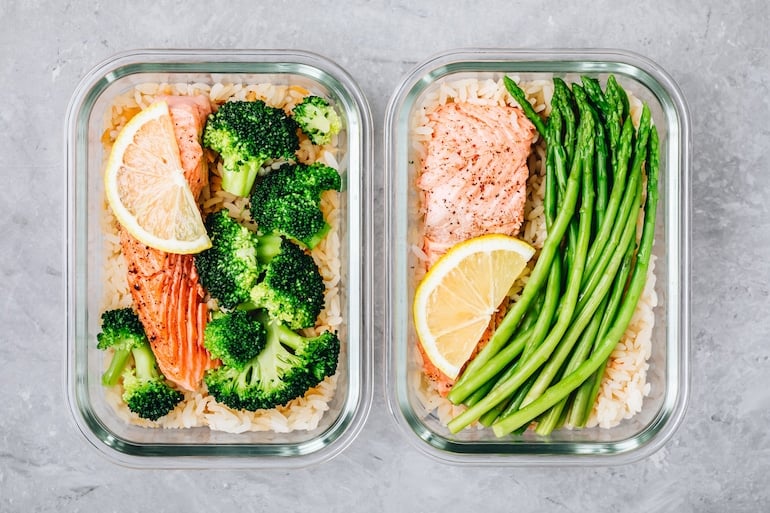
You’ve likely heard this before, but I found that seeing this in real-time was impactful for learning how my body responded to food. How does it work? Protein slows down the digestion and absorption of carbohydrates, so you won’t have the massive glucose spike that you might with a carb-only meal (think: pasta). I’m still not going to give up ever eating pizza or an almond croissant, but now I know that not only are they not the most nutrient-dense, but they’re also a blood sugar nightmare. In the future, I’ll do my best to pair these foods with a protein source to help keep things a *little* more stable.
3. Save carbs until the end of your meal.
While I didn’t have the chance to run this test on myself, a March 2020 study in the journal Clinical Nutrition found that when participants ate a meal of vegetables, chicken breast, and white rice, in that order, it reduced the glycemic response of the meal as compared to eating the meal in any other order. What I love about this tip is that it’s adoptable even without changing your diet.
4. Go heavy on the veggies.
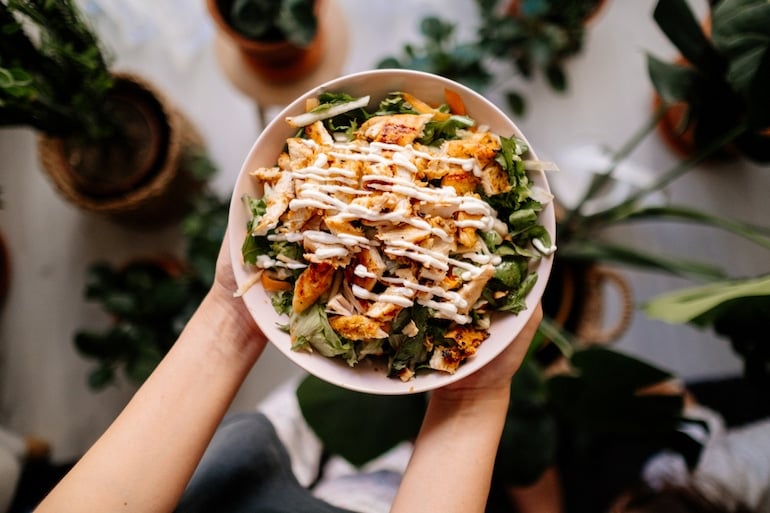
My veggie-heavy meals, like big salads with protein led to smaller peaks in glucose and my levels recovered quickly afterward, without sending me into reactive hypoglycemia. I’m also usually satisfied after a big salad, so it’s a win-win. Ensuring there is enough protein mixed in is important though because vegetables also contain carbohydrates, so a veggie-only salad may lead to a bigger spike despite being low-cal. Plus, it’ll keep you feeling fuller longer, which can help stave off mindless carb-heavy snacking (which I also learned can lead to big spikes).
5. Calories aren’t everything.
Speaking of calories, I was surprised to find just how few calories it took to quickly spike my blood sugar, especially on an empty stomach. It’s another reminder that just because something is low in calories, it doesn’t mean it’s always the best option for what your body needs in the moment.
6. There’s still so much to learn.
After seven days, I felt like I had a better sense of blood sugar, but there is still so much to learn. There were many experiments I didn’t have time to try, and those ideas were just food-related. As Collier reminds, “Do not underestimate the importance of stress management, sleep, and recovery. These behind-the-scenes factors can have a profound impact on glucose not only in the moment but also on those bigger picture trends.”Overall, I really enjoyed learning more about blood sugar management—especially how my favorite foods impacted my levels throughout the day. I would recommend trying a CGM to anyone who is interested in seeing how their body responds to food. If you’re working to maintain healthy blood sugar levels already within normal levels, HUM’s Counter Cravings can also help to naturally support balanced blood sugar for reduced cravings and boosted metabolism.
